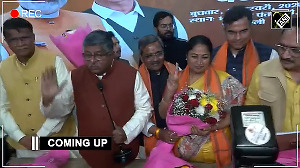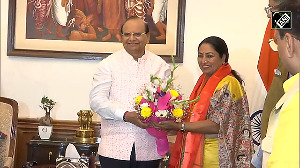The government will not adopt forcible measures to check population as had happened during the Emergency days in the 1970s, Union Health Minister Ghulam Nabi Azad said in the Lok Sabha on Wednesday.
"Once bitten twice shy," remarked Azad responding to suggestions by JD(U) chief Sharad Yadav as also Yogi Adityanath of BJP for adopting policies like those of Congress leader Sanjay Gandhi to check population.
Noting that government will not implement stringent laws to deal with rising population, he said it will not also impose "quotas" on officers on number of sterilisations and also refrain from giving out incentives likes promotions.
Favouring "'fidayeen'-like zeal" to deal with the challenge of population explosion with single-minded attention, he said "We need fidayeen...not the ones who claim lives but those who can spread awareness".
Replying to a motion in the Lok Sabha on population stabilisation in the country, he said the Centre and the states should get their act together to check the rising population, which is turning into a challenge.
Singling out Uttar Pradesh and Madhya Pradesh, Azad said the fertility rate in central Indian states was almost double the desired level, which was a matter of serious concern.
The rate of population growth, particularly in states like UP and MP, was a matter of "serious concern" as it had an adverse impact on the available national resources, Azad said.
The Total Fertility Rate (TFR) in central
A highlight of the discussion was suggestions from members like Supriya Sule (NCP), Paramjit Kaur (SAD), Hukum Dev Narain Yadav (BJP) and Pratprao Jadhav (SS) that those with more than two children should not be allowed to contest elections to assembly and Parliament.
Earlier, moving the motion, the minister said, the TFR in these states stood at an average of 3.8, which was virtually close to twice the desired rate of 2.1.
"Central India is a matter of serious concern for us. We need to change this trend. There has been no change in the TFR there and it is unfortunate," he said.
The TFR is calculated as the average number of children of a couple in their life time.
"We talk about rising costs of essential commodities, inflation
all these are a direct result of increasing population and limited availability of resources in the country," he added.
The minister said that the Population Stabilisation Policy was introduced in 2000 under the Prime Ministership of Atal Bihari Vajyapee and under which the government had set a target of achieving 2.1 TFR before 2010.
It was estimated that if this rate of TFR was achieved in the first decade, the population of the country would stabilise by 2045.
Government projections show that India's burgeoning population has seen a five-fold increase over the last 100 years and will surpass that of China by 2050.






 © 2025
© 2025